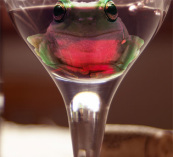 Each month New Jersey fine wine retailer Doug Salthouse, of SmartBuy Wines, selects an assorted case of wine and sends it out to me here on the west coast. I do this because Doug has a great palate and sends me many interesting wines I might have missed. In my latest shipment came a note from Doug, “I’m trying to stay away from the woody, manipulated wines you rail against.”
Each month New Jersey fine wine retailer Doug Salthouse, of SmartBuy Wines, selects an assorted case of wine and sends it out to me here on the west coast. I do this because Doug has a great palate and sends me many interesting wines I might have missed. In my latest shipment came a note from Doug, “I’m trying to stay away from the woody, manipulated wines you rail against.”
I guess he’s right, I do rail against such wines, but it’s well to remember that wood is not the enemy here. Wines like Lafon, Chateau Latour, Sottimano, Spottswoode and many others see plenty of wood and, obviously, are none the worse for it. Without a doubt many great wines would not be great without the symbiotic relationship that oak has with certain wines.
Yet the reaction of individual wines with oak is so diverse that it needs to be approached with caution. Look at the chardonnay wines from Domaine des Comte Lafon in Burgundy where the wines spend almost two years in oak and are far less oaky in flavor than many new world chardonnay wines that spend half that time in oak. What is good for the goose is not always good for the gander.
It’s not oak itself that turns my palate, but its misuse. When oak is the dominate aroma in a wine I think they’ve gone too far. A barrels main mission in maturing a wine should be that of creating an environment of controlled oxidation, not adding wood flavors, aromas and tannins. This would have to be one of the main arguments against adding wood chips and other methods that exist only to add wood flavors and aromas to the wine. However, if it is only these things we are after chips make a lot more sense than barrels. I think that wines made with wood chips and such would actually be better wines if they were only aged in stainless steel with the emphasis being on freshness and fruit rather that making some soulless imitation of barrel aged wines. All to often, oak characteristics are thought of as an essential aspect of what defines great wine. Wonderful wines from Muscadet, Beaujolais and Barolo prove this not to be the case.
One of the world’s most profound wines, Giacomo Giacosa’s Barolo Monfortino, spends seven years in barrels (obviously big ones) and is not a wine dominated by wood. What makes Monfortino great is the perfectly controlled, gentle oxidation that occurs during the years in these barrels. That process is the engine that drives the myriad of reactions and changes within the wine that bring it beyond mere greatness.
It’s only an accident that we use barrels to store wine. They were the best shipping and storage containers on hand in centuries past. This was a happy accident to be sure, because barrels have proved the perfect environment for the maturation of many wonderful wines. However, we should not assume that because they can raise tasting Lafon Montrachet to a spiritural experience that they can do the same thing for every chardonnay on the planet. Lafon’s Montrachet is great because it comes from Le Montrachet, not because it comes from a barrel.
Last night with some grilled rabbit I had the lovely 2004 Roagna Dolcetto d’Alba that Doug sent me in this month’s shipment. Not a hint of oak or any other type of wood showed in this wine and none was needed. It’s perfect just like it is.
Thanks Doug.






